Are you a tea enthusiast looking to elevate your brewing experience? Look no further! In this article, we explore the importance of selecting the right teapot material for optimal tea brewing. We’ll dive into the characteristics of various teapot materials, such as porcelain, clay, and glass, and how they can affect the taste and aroma of your favorite tea. Whether you’re a green tea connoisseur or an avid herbal tea drinker, understanding teapot materials is key to unlocking the full potential of your brew. So grab a cuppa and join us on this enlightening journey to discover the perfect teapot for your tea!
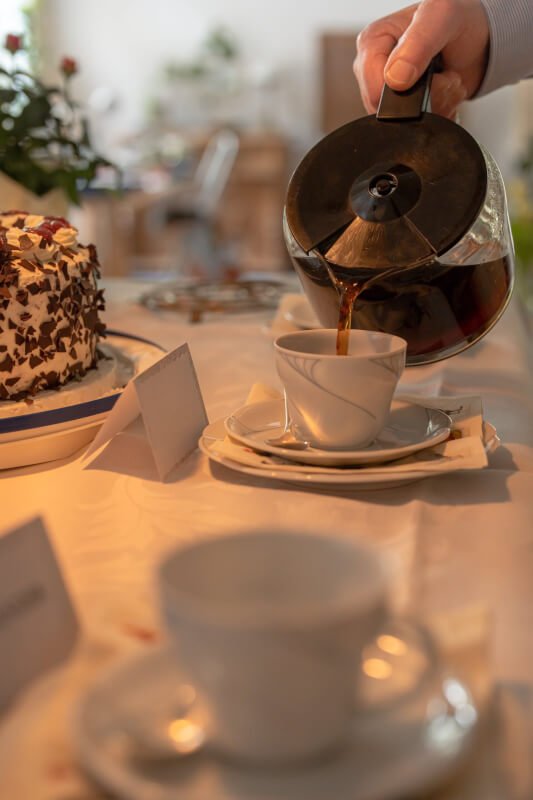
Porcelain
Overview
When it comes to teapots, porcelain is a popular choice due to its elegant appearance and versatility. Porcelain teapots are made from a high-fired white clay, resulting in a delicate and smooth surface. They are known for their ability to distribute heat evenly, which is essential for brewing tea. With its attractive design, porcelain teapots are also great for serving tea to guests.
Pros
One of the main advantages of porcelain teapots is their ability to retain heat, allowing for a longer brewing time. This is particularly beneficial for certain types of tea that require a longer steeping process, such as green and oolong teas. Additionally, the smooth surface of porcelain teapots prevents flavors from being absorbed, ensuring that the true essence of the tea is preserved.
Another advantage of porcelain teapots is their durability. Despite their delicate appearance, porcelain is a strong material that is resistant to chipping and cracking. This means that porcelain teapots can withstand regular use without losing their functionality or aesthetic appeal.
Cons
While porcelain teapots offer many advantages, there are also a few drawbacks to consider. One potential drawback is that porcelain teapots can be quite fragile, especially if they are not handled with care. Dropping or mishandling a porcelain teapot can lead to cracks or breakage, rendering it unusable.
Another disadvantage of porcelain teapots is their tendency to cool down quickly. Porcelain is not the best material for keeping tea hot for an extended period of time. If you enjoy leisurely sipping your tea, you may find yourself reheating the tea more frequently with a porcelain teapot.
Glass
Overview
Glass teapots have gained popularity in recent years due to their transparency and modern aesthetic. Made from heat-resistant glass, these teapots allow you to observe the brewing process, which adds an element of visual pleasure to your tea experience. Glass teapots are a popular choice for flowering teas, as the unfurling of the tea leaves and colorful blooms can be admired.
Pros
One of the main advantages of glass teapots is their ability to showcase the color and clarity of the tea. Whether you prefer a deep amber hue of black tea or the vibrant green of a matcha, a glass teapot allows you to appreciate the visual aspects of your brew. This can enhance your overall tea-drinking experience.
Glass teapots are also known for their neutrality in taste. Unlike some teapot materials, glass does not absorb or alter the flavors of the tea. This ensures that you get the purest essence of the tea without any added notes from the teapot material.
Cons
While glass teapots offer many benefits, they also have a few downsides to consider. Glass is a fragile material, and extra caution must be taken when handling and storing a glass teapot. Accidental bumps or drops can result in cracks or breakages, leading to a loss of functionality and potential safety hazards.
Unlike other teapot materials, glass does not retain heat as well. This means that the tea can cool down faster, making it difficult to maintain the desired temperature over an extended period of time. Additionally, glass teapots can become hot to the touch, so handling them with care is crucial to avoid burns.
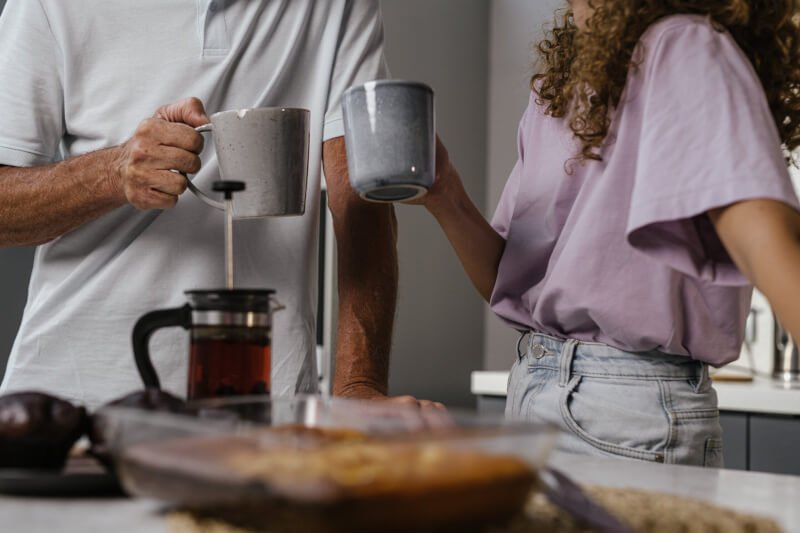
Cast Iron
Overview
Cast iron teapots, also known as Tetsubin, have a long history in Japanese tea ceremonies and have gained popularity worldwide. These teapots are made from sturdy cast iron, known for its exceptional heat retention abilities. They often feature intricate designs and are highly durable, making them a popular choice for both tea brewing and decoration purposes.
Pros
One of the main advantages of cast iron teapots is their outstanding heat retention. The thick walls of these teapots absorb and distribute heat evenly, allowing for a longer brewing time. This is particularly important for teas that require a higher brewing temperature, such as black and herbal teas. The slow release of heat from cast iron teapots also helps maintain the desired temperature throughout the brewing process.
Cast iron teapots are also known for their durability. The strength of cast iron makes it resistant to scratches, chips, and cracks. With proper care, a cast iron teapot can last for generations, becoming a treasured family heirloom.
Cons
Despite their many advantages, cast iron teapots have a few drawbacks to consider. One potential drawback is their weight. Cast iron teapots can be quite heavy, especially when filled with water and tea. This can make pouring and handling the teapot more challenging, especially for individuals with limited strength or dexterity.
Another disadvantage of cast iron teapots is their tendency to rust if not properly maintained. To prevent rusting, these teapots require thorough drying after each use and periodic seasoning with oil. The upkeep of cast iron teapots can be time-consuming and may deter some tea enthusiasts.
Stoneware
Overview
Stoneware teapots are crafted from a type of ceramic material that is fired at higher temperatures, resulting in a dense and durable final product. These teapots often feature rustic and earthy tones, adding a touch of natural elegance to any tea-drinking experience.
Pros
One of the main advantages of stoneware teapots is their excellent heat retention. The dense nature of stoneware allows it to absorb and hold heat, ensuring that your tea stays hot throughout the brewing and serving process. This is particularly beneficial when brewing teas that require higher temperatures, such as black and oolong teas.
Stoneware teapots also have a natural beauty and charm. The earthy colors and unique textures of stoneware add a sense of rusticity and authenticity to your tea experience. These teapots are often crafted by skilled artisans, resulting in one-of-a-kind pieces that can become cherished collectibles.
Cons
While stoneware teapots offer several advantages, they also have a few disadvantages. One potential drawback is their weight. Stoneware teapots tend to be heavier compared to other materials, which can make pouring and handling more challenging, especially for individuals with limited strength or mobility.
Another potential drawback is the porosity of stoneware. Unlike materials like porcelain or glass, stoneware can absorb flavors over time. This means that if you switch between different types of tea, the residue from previous brews can impact the flavor of future infusions. Proper cleaning and maintenance are essential to avoid flavor contamination.
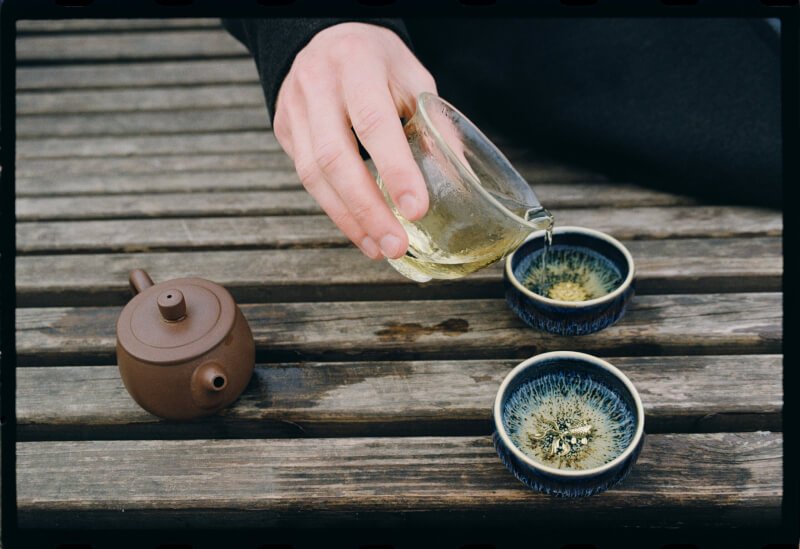
Yixing Clay
Overview
Yixing clay, also known as zisha clay, is a unique type of clay found in the Yixing region of China. Renowned for its exceptional quality, Yixing clay teapots are highly regarded among tea connoisseurs. These teapots are made from unglazed clay and are often adorned with intricate carvings and designs.
Pros
One of the main advantages of Yixing clay teapots is their ability to enhance the flavor of the tea. The porous nature of the clay allows it to absorb and retain the aroma and oils of the tea, resulting in a more flavorful brew with each successive use. Over time, the clay develops a patina that further enhances the tea’s taste.
Yixing clay teapots are also known for their exceptional heat retention. The dense nature of the clay helps maintain the desired temperature throughout the brewing process, resulting in a consistent and enjoyable tea experience.
Cons
Despite their popularity, Yixing clay teapots have a few drawbacks to consider. One potential drawback is their fragility. Yixing clay is delicate and can be easily chipped or cracked if mishandled. Extra care must be taken when using, cleaning, and storing these teapots to ensure their longevity.
Another potential drawback is the clay’s porosity. While the clay’s ability to enhance the flavor of the tea is highly regarded, it also means that the flavors can linger and transfer between different types of tea. This makes Yixing clay teapots best suited for brewing a specific type of tea to avoid flavor contamination.
Ceramic
Overview
Ceramic teapots are a versatile and widely used choice among tea enthusiasts. They are made from clay that is fired at high temperatures, resulting in a durable and smooth final product. Ceramic teapots come in a variety of designs, colors, and sizes, making it easy to find one that suits your personal style and brewing needs.
Pros
One of the main advantages of ceramic teapots is their versatility. Ceramic is a neutral material that does not react with tea, ensuring that the true flavors of the tea are preserved. Whether you enjoy delicate green teas or bold black teas, ceramic teapots can accommodate a wide range of tea varieties.
Ceramic teapots are also known for their heat retention abilities. The thick walls of ceramic help keep the tea hot for an extended period of time, allowing for leisurely sipping and multiple infusions. This makes ceramic teapots a great choice for those who prefer to make the most out of their tea leaves.
Cons
While ceramic teapots offer many advantages, they also have a few disadvantages. One potential drawback is their fragility. Ceramic teapots can be quite delicate and are prone to chipping or cracking if mishandled. Extra care must be taken when using and cleaning these teapots to avoid damage.
Another potential drawback is the weight of ceramic teapots. Compared to materials like glass or plastic, ceramic teapots can be heavier, especially when filled with water and tea. This can make pouring and handling more challenging, particularly for individuals with limited strength or dexterity.
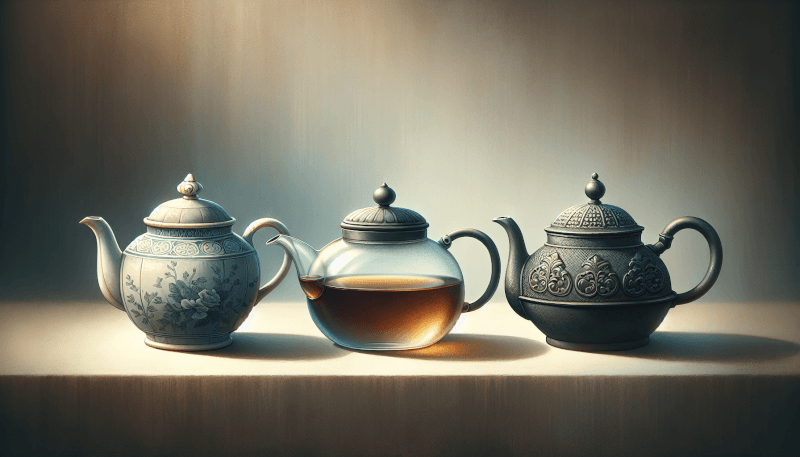
Silver
Overview
Silver teapots are a luxurious and elegant choice for tea enthusiasts. Crafted from high-quality silver, these teapots are often adorned with exquisite engravings and designs. Silver has excellent heat retention properties, making it ideal for brewing tea. Silver teapots are highly valued for their aesthetic appeal and ability to add a touch of sophistication to any tea-drinking experience.
Pros
One of the main advantages of silver teapots is their exceptional heat conductivity. Silver has the ability to heat up quickly and evenly, ensuring that your tea brews at the optimal temperature. This is particularly important for certain types of tea that require specific brewing temperatures, such as white or green teas.
Silver teapots also have the ability to retain heat, keeping your tea hot for an extended period of time. This is particularly beneficial for those who enjoy leisurely sipping their tea or hosting tea parties.
Cons
Despite their elegance, silver teapots have a few drawbacks to consider. One potential drawback is the cost. Silver teapots can be quite expensive due to the high cost of the material and the intricate craftsmanship involved in their production. This makes them more suitable for special occasions or collectors.
Another potential drawback is the maintenance required for silver teapots. Silver is susceptible to tarnishing, and regular polishing is necessary to maintain its shine. This can be time-consuming and may deter some tea enthusiasts from investing in a silver teapot.
Copper
Overview
Copper teapots have a long history in tea brewing and are still prized by tea enthusiasts today. Known for their exceptional heat retention abilities, copper teapots are often used for brewing strong and bold teas. These teapots typically have a classic and timeless design, adding a touch of elegance to any tea-drinking ritual.
Pros
One of the main advantages of copper teapots is their superb heat conductivity. Copper has excellent heat distribution properties, allowing the tea to brew evenly and quickly. This is particularly important for teas that require higher brewing temperatures, such as black or herbal teas.
Copper teapots are also known for their durability. Copper is a strong and sturdy material that can withstand regular use without losing its functionality or aesthetic appeal. With proper care, a copper teapot can last for generations, becoming a cherished heirloom.
Cons
While copper teapots offer many benefits, there are also a few drawbacks to consider. One potential drawback is the maintenance required. Copper can tarnish over time, and regular polishing is necessary to maintain its lustrous appearance. Additionally, copper can react with certain acids present in tea, leading to a metallic taste. Coating the interior of the teapot with another metal, such as tin, can help alleviate this issue.
Another potential drawback is the weight of copper teapots. Copper is a dense material, and teapots made from copper can be quite heavy. This can make pouring and handling more challenging, especially for individuals with limited strength or mobility.
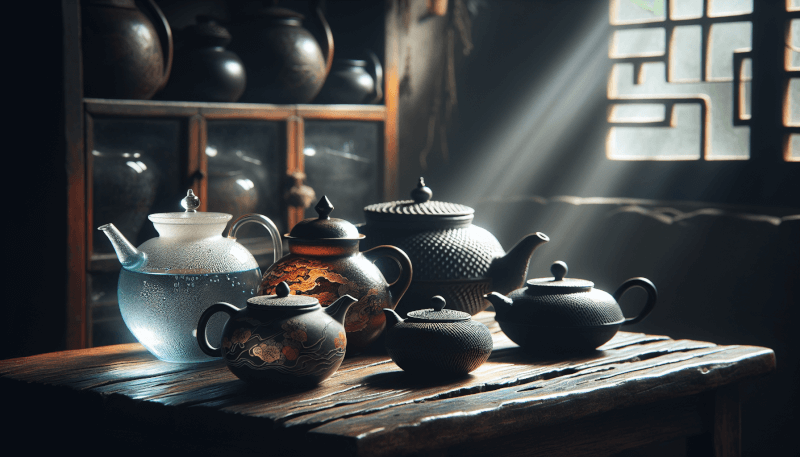
Aluminum
Overview
Aluminum teapots are lightweight and affordable options for tea lovers. Known for their excellent heat conductivity, aluminum teapots heat up quickly and evenly, ensuring a consistent brewing experience. These teapots are often chosen for their practicality and efficiency.
Pros
One of the main advantages of aluminum teapots is their lightweight nature. Aluminum is a relatively lightweight material, making it easy to handle and pour tea without straining your muscles. This makes aluminum teapots a great choice for those who find heavier teapots difficult to manage.
Aluminum teapots also have excellent heat conductivity. This means that they heat up quickly and distribute heat evenly, ensuring that your tea brews at the optimal temperature. Aluminum teapots are particularly suited for teas that require lower brewing temperatures, such as green or white teas.
Cons
Despite their practicality, aluminum teapots have a few drawbacks to consider. One potential drawback is their durability. Aluminum is a softer material compared to others, and it can dent or scratch easily if mishandled. Extra care must be taken when using and cleaning aluminum teapots to avoid damage.
Another potential drawback is the need for a protective coating. Aluminum can react with certain teas, resulting in an undesirable metallic taste. To prevent this, many aluminum teapots have a non-reactive coating applied to the interior. It is essential to ensure that this coating is food-safe and in good condition to avoid any potential health concerns.
Plastic
Overview
Plastic teapots are a lightweight and affordable option for those seeking convenience and portability. Made from durable and food-safe plastics, these teapots are often chosen for their practicality and ease of use. Plastic teapots come in various colors and designs, offering a wide range of choices to suit different preferences.
Pros
One of the main advantages of plastic teapots is their lightweight nature. Plastic is a lightweight material, making it easy to handle and pour tea without straining your muscles. This makes plastic teapots ideal for picnics, travel, or anyone looking for a portable tea brewing solution.
Plastic teapots are also known for their durability. Plastic is a sturdy material that can withstand regular use without breaking or chipping. This makes plastic teapots a great choice for everyday tea brewing, especially in households with children or those who prefer a more casual tea-drinking experience.
Cons
While plastic teapots offer convenience, there are a few drawbacks to consider. One potential drawback is the risk of plastic leaching chemicals into the tea. To ensure the safety of your tea, it is essential to choose a plastic teapot made from food-safe materials and avoid exposing the teapot to high temperatures or acidic teas.
Another potential drawback is the lack of heat retention. Plastic teapots do not retain heat as well as other materials, and the tea may cool down quickly. This can be a disadvantage for those who prefer leisurely sipping or multiple infusions without reheating the tea.
In conclusion, choosing the right teapot material for optimal tea brewing is a matter of personal preference and specific brewing needs. Each material has its own advantages and disadvantages, and it’s important to consider factors such as heat retention, durability, and aesthetic appeal. Whether you prefer the elegance of porcelain, the transparency of glass, the heat retention of cast iron, or the natural beauty of stoneware, there is a teapot material that will suit your needs and enhance your tea-drinking experience. Happy brewing!

